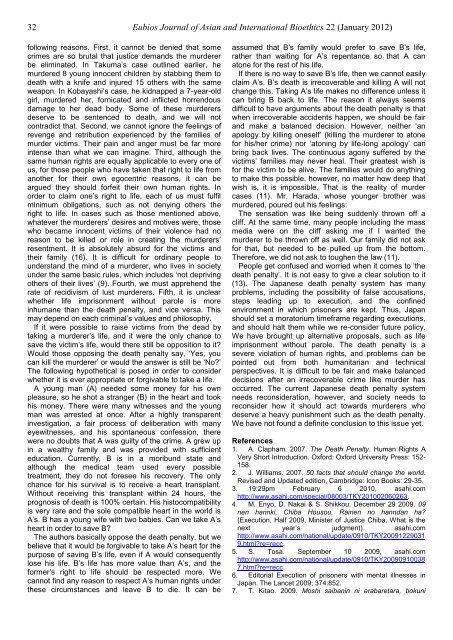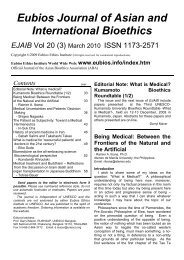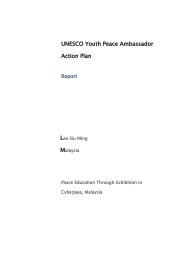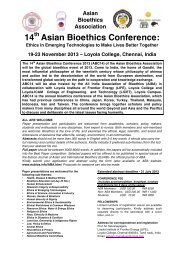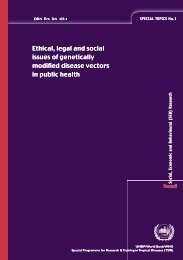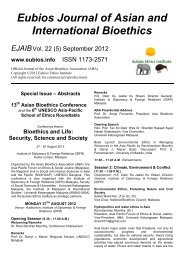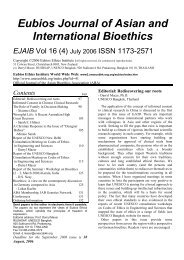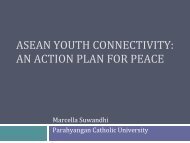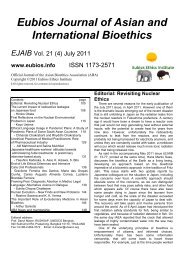Eubios Journal of Asian and International Bioethics - Eubios Ethics ...
Eubios Journal of Asian and International Bioethics - Eubios Ethics ...
Eubios Journal of Asian and International Bioethics - Eubios Ethics ...
Create successful ePaper yourself
Turn your PDF publications into a flip-book with our unique Google optimized e-Paper software.
32 <strong>Eubios</strong> <strong>Journal</strong> <strong>of</strong> <strong>Asian</strong> <strong>and</strong> <strong>International</strong> <strong>Bioethics</strong> 22 (January 2012)<br />
following reasons. First, it cannot be denied that some<br />
crimes are so brutal that justice dem<strong>and</strong>s the murderer<br />
be eliminated. In Takuma’s case outlined earlier, he<br />
murdered 8 young innocent children by stabbing them to<br />
death with a knife <strong>and</strong> injured 15 others with the same<br />
weapon. In Kobayashi’s case, he kidnapped a 7-year-old<br />
girl, murdered her, fornicated <strong>and</strong> inflicted horrendous<br />
damage to her dead body. Some <strong>of</strong> these murderers<br />
deserve to be sentenced to death, <strong>and</strong> we will not<br />
contradict that. Second, we cannot ignore the feelings <strong>of</strong><br />
revenge <strong>and</strong> retribution experienced by the families <strong>of</strong><br />
murder victims. Their pain <strong>and</strong> anger must be far more<br />
intense than what we can imagine. Third, although the<br />
same human rights are equally applicable to every one <strong>of</strong><br />
us, for those people who have taken that right to life from<br />
another for their own egocentric reasons, it can be<br />
argued they should forfeit their own human rights. In<br />
order to claim one’s right to life, each <strong>of</strong> us must fulfil<br />
minimum obligations, such as not denying others the<br />
right to life. In cases such as those mentioned above,<br />
whatever the murderers’ desires <strong>and</strong> motives were, those<br />
who became innocent victims <strong>of</strong> their violence had no<br />
reason to be killed or role in creating the murderers’<br />
resentment. It is absolutely absurd for the victims <strong>and</strong><br />
their family (16). It is difficult for ordinary people to<br />
underst<strong>and</strong> the mind <strong>of</strong> a murderer, who lives in society<br />
under the same basic rules, which includes ‘not depriving<br />
others <strong>of</strong> their lives’ (9). Fourth, we must apprehend the<br />
rate <strong>of</strong> recidivism <strong>of</strong> lust murderers. Fifth, it is unclear<br />
whether life imprisonment without parole is more<br />
inhumane than the death penalty, <strong>and</strong> vice versa. This<br />
may depend on each criminal’s values <strong>and</strong> philosophy.<br />
If it were possible to raise victims from the dead by<br />
taking a murderer’s life, <strong>and</strong> it were the only chance to<br />
save the victim’s life, would there still be opposition to it?<br />
Would those opposing the death penalty say, ‘Yes, you<br />
can kill the murderer’ or would the answer is still be ‘No?’<br />
The following hypothetical is posed in order to consider<br />
whether it is ever appropriate or forgivable to take a life.<br />
A young man (A) needed some money for his own<br />
pleasure, so he shot a stranger (B) in the heart <strong>and</strong> took<br />
his money. There were many witnesses <strong>and</strong> the young<br />
man was arrested at once. After a highly transparent<br />
investigation, a fair process <strong>of</strong> deliberation with many<br />
eyewitnesses, <strong>and</strong> his spontaneous confession, there<br />
were no doubts that A was guilty <strong>of</strong> the crime. A grew up<br />
in a wealthy family <strong>and</strong> was provided with sufficient<br />
education. Currently, B is in a moribund state <strong>and</strong><br />
although the medical team used every possible<br />
treatment, they do not foresee his recovery. The only<br />
chance for his survival is to receive a heart transplant.<br />
Without receiving this transplant within 24 hours, the<br />
prognosis <strong>of</strong> death is 100% certain. His histocompatibility<br />
is very rare <strong>and</strong> the sole compatible heart in the world is<br />
A’s. B has a young wife with two babies. Can we take A’s<br />
heart in order to save B?<br />
The authors basically oppose the death penalty, but we<br />
believe that it would be forgivable to take A’s heart for the<br />
purpose <strong>of</strong> saving B’s life, even if A would consequently<br />
lose his life. B’s life has more value than A’s, <strong>and</strong> the<br />
former’s right to life should be respected more. We<br />
cannot find any reason to respect A’s human rights under<br />
these circumstances <strong>and</strong> leave B to die. It can be<br />
assumed that B’s family would prefer to save B’s life,<br />
rather than waiting for A’s repentance so that A can<br />
atone for the rest <strong>of</strong> his life.<br />
If there is no way to save B’s life, then we cannot easily<br />
claim A’s. B’s death is irrecoverable <strong>and</strong> killing A will not<br />
change this. Taking A’s life makes no difference unless it<br />
can bring B back to life. The reason it always seems<br />
difficult to have arguments about the death penalty is that<br />
when irrecoverable accidents happen, we should be fair<br />
<strong>and</strong> make a balanced decision. However, neither ‘an<br />
apology by killing oneself’ (killing the murderer to atone<br />
for his/her crime) nor ‘atoning by life-long apology’ can<br />
bring back lives. The continuous agony suffered by the<br />
victims’ families may never heal. Their greatest wish is<br />
for the victim to be alive. The families would do anything<br />
to make this possible, however, no matter how deep that<br />
wish is, it is impossible. That is the reality <strong>of</strong> murder<br />
cases (11). Mr. Harada, whose younger brother was<br />
murdered, poured out his feelings:<br />
The sensation was like being suddenly thrown <strong>of</strong>f a<br />
cliff. At the same time, many people including the mass<br />
media were on the cliff asking me if I wanted the<br />
murderer to be thrown <strong>of</strong>f as well. Our family did not ask<br />
for that, but needed to be pulled up from the bottom.<br />
Therefore, we did not ask to toughen the law (11).<br />
People get confused <strong>and</strong> worried when it comes to ‘the<br />
death penalty’. It is not easy to give a clear solution to it<br />
(13). The Japanese death penalty system has many<br />
problems, including the possibility <strong>of</strong> false accusations,<br />
steps leading up to execution, <strong>and</strong> the confined<br />
environment in which prisoners are kept. Thus, Japan<br />
should set a moratorium timeframe regarding executions,<br />
<strong>and</strong> should halt them while we re-consider future policy.<br />
We have brought up alternative proposals, such as life<br />
imprisonment without parole. The death penalty is a<br />
severe violation <strong>of</strong> human rights, <strong>and</strong> problems can be<br />
pointed out from both humanitarian <strong>and</strong> technical<br />
perspectives. It is difficult to be fair <strong>and</strong> make balanced<br />
decisions after an irrecoverable crime like murder has<br />
occurred. The current Japanese death penalty system<br />
needs reconsideration, however, <strong>and</strong> society needs to<br />
reconsider how it should act towards murderers who<br />
deserve a heavy punishment such as the death penalty.<br />
We have not found a definite conclusion to this issue yet.<br />
References<br />
1. A. Clapham. 2007. The Death Penalty. Human Rights A<br />
Very Short Introduction. Oxford: Oxford University Press: 152-<br />
158.<br />
2. J. Williams. 2007. 50 facts that should change the world.<br />
Revised <strong>and</strong> Updated edition, Cambridge: Icon Books: 29-35.<br />
3. 19:29pm February 6 2010, asahi.com<br />
http://www.asahi.com/special/08003/TKY201002060263.<br />
4. M. Enyo, D. Nakai & S. Shikkou. December 29 2009. 09<br />
nen hannki, Chiba Housou, Rainen no hanndan ha?<br />
(Execution, Half 2009, Minister <strong>of</strong> Justice Chiba, What is the<br />
next year’s judgment) asahi.com<br />
http://www.asahi.com/national/update/0910/TKY20091229031<br />
9.html?re=recc.<br />
5. S. Tosa. September 10 2009, asahi.com<br />
http://www.asahi.com/national/update/0910/TKY20090910038<br />
7.html?re=recc.<br />
6. Editorial Execution <strong>of</strong> prisoners with mental illnesses in<br />
Japan. The Lancet 2009; 374:852.<br />
7. T. Kitao. 2009. Moshi saibanin ni erabaretara, bokuni


